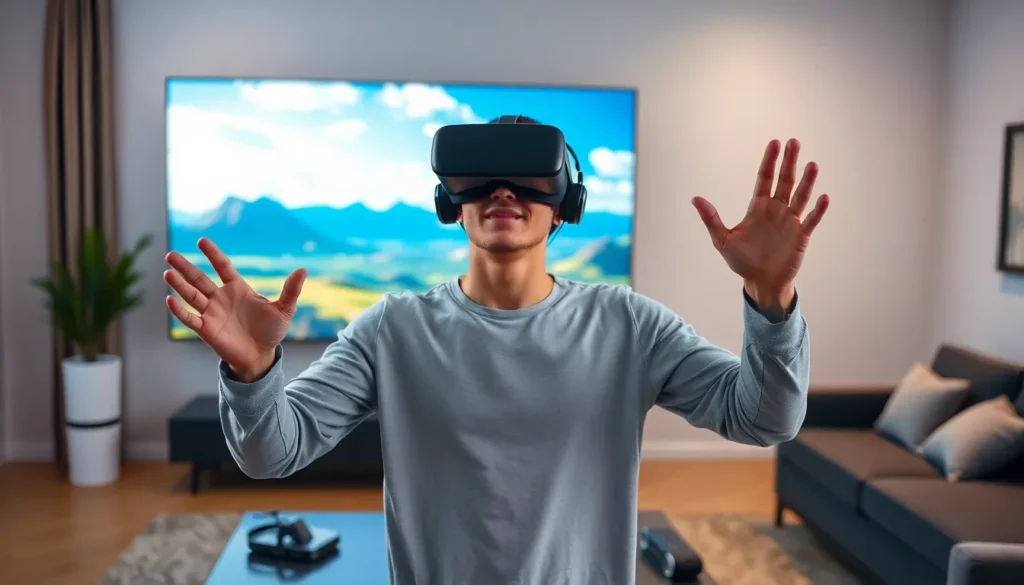Virtual reality isn’t just for gamers anymore; it’s the new frontier reshaping industries from education to healthcare. With a headset on, users can explore a world where the only limit is imagination. Gone are the days of boring lectures and stale training sessions—VR makes learning an immersive adventure.
As technology evolves, so does the potential of virtual reality. Businesses are jumping on the bandwagon, realizing that VR can enhance customer experiences and boost engagement like never before. Imagine attending a concert from your living room or trying on clothes without stepping foot in a store. The growth of virtual reality is not just a trend; it’s a revolution that’s here to stay. Buckle up as we dive into the exciting world of VR and explore how it’s changing the game for everyone.
Table of Contents
ToggleOverview of Virtual Reality Growth
Virtual reality (VR) has experienced remarkable growth in recent years, becoming an essential technology across multiple sectors. The global VR market size is projected to reach $57.55 billion by 2027, growing at a compound annual growth rate (CAGR) of 44.5% from 2020 to 2027. This highlights a trend toward increased adoption in diverse fields such as education, healthcare, and retail.
In education, VR transforms the learning experience by creating immersive environments. Students now participate in virtual classrooms and simulations, enhancing engagement and understanding of complex concepts. For instance, medical students can practice surgeries within a virtual environment, accessing realistic scenarios without putting patients at risk.
Healthcare harnesses VR for therapy and rehabilitation. Patients suffering from PTSD and phobias benefit from exposure therapy, where controlled virtual environments facilitate progress. Such advancements showcase the technology’s potential to improve mental well-being and expand treatment options.
Retail businesses leverage VR to create interactive shopping experiences. Consumers can explore virtual stores and visualize products in their homes. Companies like IKEA utilize VR to allow customers to design and furnish spaces before making purchases. This personalized approach enhances satisfaction and reduces returns.
Virtual concerts and events also gain traction as VR fosters innovative ways for engagement. Artists perform live in virtual arenas, increasing accessibility for fans worldwide. Merging technology with entertainment, this development illustrates how VR redefines social interactions in the entertainment industry.
Overall, the growth of virtual reality reflects its potential to revolutionize various industries, reshaping how individuals experience and interact with information, services, and entertainment.
Factors Driving Virtual Reality Growth

Virtual reality (VR) experiences continue to expand due to several key factors. This growth stems from both advancements in technology and increased consumer demand.
Technological Advancements
Improvements in hardware and software significantly contribute to the expansion of VR. Enhanced graphics processing units (GPUs) allow for smoother and more realistic simulations. Breakthroughs in display technology, such as OLED and high refresh rates, improve user comfort and immersion. Additionally, developments in tracking systems ensure more precise movements within virtual environments. Companies invest heavily in innovations, creating a more accessible and affordable market for consumers. As technologies mature, the overall quality and appeal of VR systems increase, driving wider adoption across various sectors.
Increased Consumer Demand
Growing consumer interest plays a crucial role in the rise of virtual reality. More individuals seek immersive experiences, particularly in gaming and entertainment. The surge in home entertainment options drives demand for VR headsets as consumers desire innovative ways to engage with content. Social media trends also amplify this interest, as users share their virtual experiences online. Moreover, companies target various demographics, highlighting VR’s versatility for education and training. As these demands increase, businesses enhance their VR offerings, leading to a robust upward trend in the sector.
Applications of Virtual Reality
Virtual reality applications span multiple sectors, transforming traditional practices into immersive experiences. Industries like entertainment, education, and healthcare leverage VR for significant advancements.
Entertainment and Gaming
Entertainment and gaming industries continually evolve through VR technology. Gamers engage in realistic environments that enhance their overall experience. Popular titles increasingly incorporate VR, offering players unique interactions that surpass conventional gaming. Various platforms, such as Oculus and PlayStation VR, showcase advanced capabilities, making immersive gaming accessible to a broader audience. Streaming platforms explore virtual concerts, enabling fans to enjoy live performances from home. Artists can perform in virtual arenas, creating interactive experiences for global audiences. Virtual reality solidifies its role as a key player in shaping the entertainment landscape.
Education and Training
Education and training sectors harness VR to revolutionize learning processes. Students participate in stimulating environments that enrich traditional classroom experiences. Interactive simulations allow for skill development in safe, risk-free settings. Medical training benefits significantly; aspiring surgeons can practice procedures through VR simulations, gaining hands-on experience without consequences. Businesses deploy VR for employee training, offering realistic scenarios tailored to specific tasks and challenges. Engaging sessions improve retention and understanding, heightening the overall effectiveness of training programs. By embracing these advancements, educational institutions and organizations position themselves at the forefront of modern learning practices.
Challenges Facing Virtual Reality Growth
Virtual reality (VR) growth encounters several significant challenges that impact its widespread adoption. Identifying these challenges is crucial for overcoming barriers and fostering future advancements.
Cost and Accessibility
Costs associated with VR technology remain high, limiting access to a broader audience. High-end VR headsets can exceed $1,000, while additional costs for compatible hardware create further financial hurdles. Accessibility issues also arise for individuals with disabilities, who may find it challenging to use VR experiences without customized adaptations. Affordability and accessibility must improve for VR to reach diverse demographics. Organizations can enhance this by developing budget-friendly solutions and advocating for inclusive designs in VR.
Content Creation and Development
Creating compelling VR content poses another significant hurdle. Developers face challenges with high production costs, requiring substantial technical expertise and investment. Limitations regarding available tools and platforms complicate the development process, stifling innovation. A lack of standardized formats further hinders cross-compatibility between different VR systems. As VR technology advances, investing in user-friendly development tools can streamline content creation. Promoting collaboration among developers can also lead to a broader range of high-quality immersive experiences.
Future Trends in Virtual Reality
Innovative developments continue shaping the future of virtual reality (VR). The gaming sector remains a leader in driving demand, as companies enhance user engagement through realistic graphics and interactive environments. By 2027, the VR market is set to exceed $57.55 billion, with a compound annual growth rate of 44.5%.
Education sectors increasingly embrace immersive VR experiences. Schools and universities utilize this technology to create engaging learning environments. Practical simulations enable students to participate in hands-on experiences, especially invaluable in fields like medicine and engineering.
Healthcare applications will expand substantially. VR therapy offers unique approaches for treating conditions such as PTSD and phobias. Innovations in VR design promise more personalized therapeutic experiences, making treatment more accessible for patients.
Retail industries also leverage VR to transform shopping experiences. Consumers can visualize products within their environments, enhancing decision-making processes. Companies like IKEA exemplify this trend by allowing customers to place virtual furniture in their homes before purchase.
Entertainment venues are reimagining their offerings. Virtual concerts attract fans who can enjoy performances from their homes. Artists and event organizers tap into these opportunities to create unique, interactive experiences, redefining audience engagement.
However, challenges remain that hinder widespread adoption of VR technology. High costs of advanced headsets pose barriers for many potential users. Accessibility issues for individuals with disabilities complicate matters further. Additionally, the high production costs of quality content and lack of standardized formats can stifle innovation.
Promising solutions to these challenges include budget-friendly technologies and inclusive design practices. Developments in user-friendly tools for content creation can encourage widespread participation in the VR environment, fostering continual growth and evolution.
The growth of virtual reality is reshaping industries and enhancing user experiences in unprecedented ways. As VR technology continues to evolve it opens doors to innovative applications in education healthcare and entertainment. Businesses that embrace VR are not only improving customer engagement but also redefining how consumers interact with products and services.
Despite challenges like high costs and accessibility issues the future of VR looks promising. With ongoing advancements in technology and a focus on inclusive design the potential for widespread adoption is within reach. As the market expands and more sectors recognize VR’s transformative power it’s clear that this immersive technology will play a crucial role in shaping the future.

